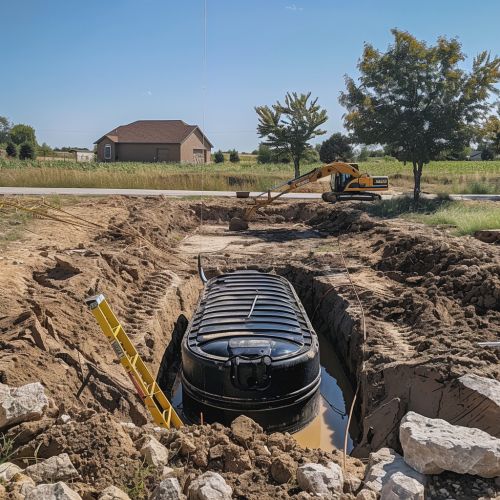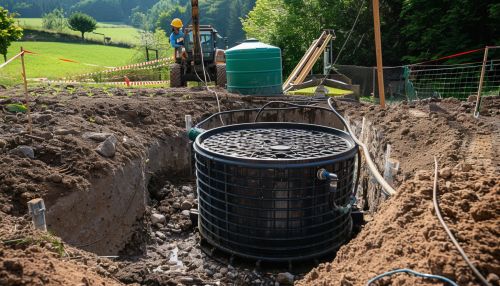Septic systems
Introduction
A **septic system** is an underground wastewater treatment structure commonly used in rural areas without centralized sewer systems. These systems utilize a combination of nature and technology to treat wastewater from household plumbing produced by bathrooms, kitchen drains, and laundry. Septic systems are crucial for managing and disposing of domestic sewage in a safe and environmentally friendly manner.
Components of a Septic System
A typical septic system consists of two main parts: a septic tank and a drainfield (also known as a leach field).
Septic Tank
The septic tank is a watertight container made of concrete, fiberglass, or polyethylene, typically buried underground. Its primary function is to hold wastewater long enough to allow solids to settle down to the bottom, forming sludge, while oil and grease float to the top as scum. The tank's design ensures that only the liquid effluent exits the tank and flows into the drainfield.


Drainfield
The drainfield is a shallow, covered excavation made in unsaturated soil. It receives the effluent from the septic tank and disperses it into the soil. The soil acts as a biological filter, removing harmful bacteria, viruses, and nutrients. The size and type of drainfield depend on the soil's absorption capacity, the volume of wastewater, and local regulations.
Types of Septic Systems
There are several types of septic systems, each designed to suit different site conditions and wastewater treatment needs.
Conventional Systems
Conventional systems are the most common type of septic systems. They consist of a septic tank and a trench or bed subsurface wastewater infiltration system. These systems are suitable for areas with adequate soil depth and permeability.
Chamber Systems
Chamber systems are an alternative to conventional gravel-filled drainfields. They use plastic chambers to create an open area for effluent to flow through and infiltrate the soil. These systems are advantageous in areas with high groundwater tables or poor soil conditions.
Drip Distribution Systems
Drip distribution systems distribute effluent through a network of small-diameter pipes placed at shallow depths. This method allows for more uniform distribution and is suitable for areas with shallow soils or steep slopes.
Mound Systems
Mound systems are used in areas with shallow soil depth, high groundwater, or bedrock. They consist of a sand mound constructed above the natural soil surface, with a drainfield installed within the mound. The mound provides additional treatment and dispersal of effluent.
Aerobic Treatment Units (ATUs)
ATUs use oxygen to break down organic matter more efficiently than conventional septic systems. These systems include an aeration chamber where air is introduced to promote the growth of aerobic bacteria, which decompose the waste. ATUs are suitable for areas with poor soil conditions or where higher levels of treatment are required.
Design and Installation
The design and installation of a septic system must comply with local regulations and site-specific conditions. Key factors to consider include soil type, topography, groundwater levels, and the volume of wastewater generated.
Site Evaluation
A thorough site evaluation is essential to determine the suitability of a location for a septic system. This evaluation includes soil testing, percolation tests, and an assessment of the site's topography and drainage patterns.
System Design
The design of a septic system involves selecting the appropriate type of system, sizing the septic tank and drainfield, and planning the layout to ensure proper function and compliance with regulations. The design must account for peak wastewater flow, soil absorption capacity, and environmental protection.
Installation
Proper installation is critical to the long-term performance of a septic system. This process includes excavating the site, installing the septic tank and drainfield components, and ensuring that all connections are watertight. The installation must be inspected and approved by local authorities before the system is put into operation.
Maintenance and Inspection
Regular maintenance and inspection are crucial to the longevity and effectiveness of a septic system. Neglecting maintenance can lead to system failure, environmental contamination, and costly repairs.
Pumping the Septic Tank
The septic tank should be pumped regularly to remove accumulated sludge and scum. The frequency of pumping depends on the tank size, household size, and the volume of solids in the wastewater. Typically, septic tanks should be pumped every 3 to 5 years.
Inspecting the System
Regular inspections help identify potential issues before they become major problems. Inspections should include checking the septic tank for leaks or cracks, assessing the drainfield for signs of failure, and ensuring that all components are functioning correctly.
Preventative Measures
Homeowners can take several preventative measures to protect their septic system, including:
- Avoiding the disposal of non-biodegradable materials, grease, and chemicals down the drain.
- Conserving water to reduce the volume of wastewater entering the system.
- Protecting the drainfield from heavy machinery and excessive water runoff.
Environmental Impact
Septic systems play a critical role in protecting public health and the environment by treating and dispersing wastewater. However, poorly designed or maintained systems can pose significant environmental risks.
Groundwater Contamination
One of the primary environmental concerns associated with septic systems is the potential for groundwater contamination. If a system fails or is improperly maintained, pathogens, nutrients, and chemicals can leach into the groundwater, posing a risk to drinking water supplies and aquatic ecosystems.
Surface Water Pollution
Effluent from failing septic systems can also reach surface water bodies, leading to nutrient enrichment and the proliferation of harmful algal blooms. These blooms can deplete oxygen levels in the water, harming fish and other aquatic life.
Soil Degradation
Excessive effluent loading can lead to soil degradation, reducing its ability to filter and treat wastewater effectively. This can result in the accumulation of contaminants in the soil and the eventual failure of the septic system.
Advances in Septic System Technology
Recent advancements in septic system technology aim to improve the efficiency and environmental performance of these systems.
Enhanced Treatment Systems
Enhanced treatment systems incorporate additional treatment processes, such as sand filters, peat filters, or constructed wetlands, to provide higher levels of effluent treatment. These systems are particularly useful in environmentally sensitive areas or where conventional systems are unsuitable.
Remote Monitoring
Remote monitoring technology allows for real-time tracking of septic system performance. Sensors can detect issues such as high water levels, pump failures, or blockages, enabling timely maintenance and reducing the risk of system failure.
Alternative Materials
Innovations in materials, such as the use of lightweight, durable plastics for septic tanks and drainfield components, offer improved longevity and ease of installation. These materials can also reduce the environmental footprint of septic system construction.
Regulatory Framework
Septic systems are regulated at the local, state, and federal levels to ensure public health and environmental protection.
Local Regulations
Local health departments typically oversee the permitting, design, installation, and inspection of septic systems. Regulations vary by jurisdiction but generally include requirements for site evaluation, system design, and maintenance.
State Regulations
State environmental agencies may establish standards for septic system performance, including effluent quality and system siting. States may also provide guidelines for alternative and innovative systems.
Federal Regulations
While the federal government does not directly regulate septic systems, it provides guidance and support through agencies such as the Environmental Protection Agency (EPA). The EPA's Onsite Wastewater Treatment Systems Manual offers comprehensive information on the design, operation, and maintenance of septic systems.
Challenges and Considerations
Several challenges and considerations must be addressed to ensure the effective management of septic systems.
Aging Infrastructure
Many existing septic systems are aging and may not meet current standards or performance expectations. Upgrading or replacing these systems can be costly and logistically challenging.
Climate Change
Climate change can impact the performance of septic systems by altering precipitation patterns, increasing the frequency of extreme weather events, and raising groundwater levels. These changes may necessitate adaptations in system design and management.
Public Awareness
Raising public awareness about the importance of proper septic system maintenance and the potential environmental impacts of system failure is crucial. Education and outreach programs can help homeowners understand their responsibilities and take proactive measures to protect their systems.
Conclusion
Septic systems are essential for managing wastewater in areas without centralized sewer systems. Proper design, installation, and maintenance are critical to ensuring their effectiveness and minimizing environmental impacts. Advances in technology and regulatory frameworks continue to improve the performance and sustainability of septic systems, addressing the challenges posed by aging infrastructure and climate change.
